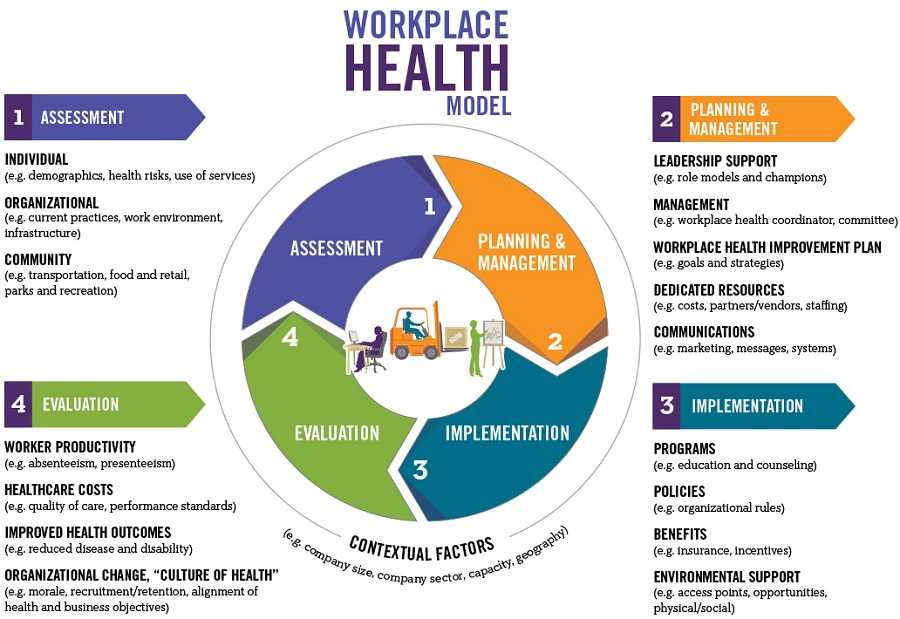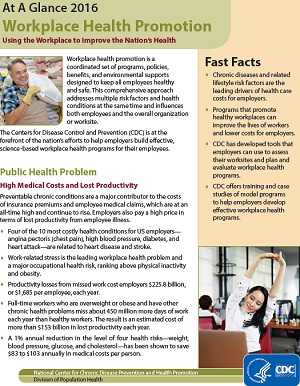Workplace Health Promotion
Using the Workplace to Improve the Nation’s Health
At A Glance 2016
Workplace health promotion is a coordinated set of programs, policies, benefits, and environmental supports designed to keep all employees healthy and safe. This comprehensive approach addresses multiple risk factors and health conditions at the same time and influences both employees and the overall organization or worksite.
The Centers for Disease Control and Prevention (CDC) is at the forefront of the nation’s efforts to help employers build effective, science-based workplace health programs for their employees.
Public Health Problem
High Medical Costs and Lost Productivity
Preventable chronic conditions are a major contributor to the costs of insurance premiums and employee medical claims, which are at an all-time high and continue to rise. Employers also pay a high price in terms of lost productivity from employee illness.
- Four of the 10 most costly health conditions for US employers— angina pectoris (chest pain), high blood pressure, diabetes, and heart attack—are related to heart disease and stroke.
- Work-related stress is the leading workplace health problem and a major occupational health risk, ranking above physical inactivity and obesity.
- Productivity losses from missed work cost employers $225.8 billion, or $1,685 per employee, each year.
- Full-time workers who are overweight or obese and have other chronic health problems miss about 450 million more days of work each year than healthy workers. The result is an estimated cost of more than $153 billion in lost productivity each year.
- A 1% annual reduction in the level of four health risks—weight, blood pressure, glucose, and cholesterol—has been shown to save $83 to $103 annually in medical costs per person.
Unrealized Potential for Workplace Health Promotion
Workplace programs that promote and protect health and help prevent disease could potentially reach more than 159 million workers across the United States. On average, Americans who work full-time spend more than one-third of their day, 5 days a week, at their workplace. Employers have a responsibility to provide a safe, hazard-free workplace for their employees. They also have an opportunity to promote individual health and create a healthy work environment.
Effective workplace programs and policies can reduce health risks and improve the quality of life for US workers. A healthier workforce can mean lower direct costs, such as insurance premiums and workers’ compensation claims. It can also translate to lower indirect costs if workers miss less work because of illness. Still, too few employers are using effective, science-based workplace health programs.
CDC’s Response
The National Center for Chronic Disease Prevention and Health Promotion (NCCDPHP) works in four key areas or domains: epidemiology and surveillance, environmental approaches, health care system interventions, and community programs linked to clinical services. This comprehensive approach supports healthy choices and behaviors, makes healthier options more available, and helps Americans better manage their health. CDC’s Workplace Health Promotion Program supports these efforts by focusing its activities in two of NCCDPHP’s four domains: epidemiology and surveillance and environmental approaches.
Specifically, the program works with employers and other partners to encourage use of the strategies in CDC’s Workplace Health Model. CDC focuses on small and midsize employers (74% of US employers have fewer than 100 employees), which often lack the expertise and resources to develop effective programs and may not engage with the public health system. The agency:
Related Materials
Fast Facts
- Chronic diseases and related lifestyle risk factors are the leading drivers of health care costs for employers.
- Programs that promote healthy workplaces can improve the lives of workers and lower costs for employers.
- CDC has developed tools that employers can use to assess their worksites and plan and evaluate workplace health programs.
- CDC offers training and case studies of model programs to help employers develop effective workplace health programs.

- Provides employers with tools and resources that build their skills to set up effective and sustainable workplace health strategies.
- Conducts research to find and test promising strategies and interventions.
- Monitors and reports trends in employer programs, policies, and practices to find out what is needed.
- Helps workplaces identify changes they can make to support employees who want to protect and maintain their health.

Epidemiology and Surveillance
Collecting Data
CDC developed the new Workplace Health in America survey to assess the organizational structure, characteristics, and practices of workplace health programs. Although other surveys of workplace health programs have been conducted over the past 25 years, no systematic effort has been made to document strategies that make up an effective program from a representative sample of US employers. The Workplace Health in America survey will address this gap by collecting data about health programs, policies, and benefits; environmental supports; leadership; infrastructure; and capacity. It will help establish a surveillance system that tracks these efforts.
The resulting data can be used to create recommendations, guidelines, and solutions for US employers and to evaluate national health priorities, such as Healthy People 2020 objectives. Results of the first survey, in 2016, will be available in 2017.
CDC also developed the Worksite Health ScoreCard to help employers identify gaps in their programs and decide which strategies will work best for their organizations, such as leadership support; wellness champions and committees; tobacco control programs; occupational safety and health programs; and interventions designed to address nutrition, physical activity, stress management, depression, high blood pressure, and diabetes. The Workplace Health Promotion Program also provides technical assistance on the ScoreCard to state health departments in support of CDC’s State Public Health Actions program, which addresses diabetes, heart disease, obesity, and school health.
Using the ScoreCard, over 1,500 worksites representing 46 states and 1 US territory assessed how proven health promotion strategies had been used in their worksites since 2013.
Identifying Best Practices
CDC supports research to learn what interventions and practices are most effective in helping employers improve the health and well-being of their workers (especially small and midsize employers).
A CDC Workplace Health Resource Center is being developed and will include CDC guidelines, Community Guide reviews, turn-key interventions, and plug-and-play resources. This resource center will expand the availability of credible, science-based tools and resources.
Through the Prevention Research Centers Program, CDC created a Workplace Health Research Network (WHRN) which was funded in 2014 and 2015 to engage employers, employees, and communities to research and use effective, comprehensive, and integrated approaches to promote and protect worker health, safety, and well-being.
Environmental Approaches
In 2014, CDC launched an employer training program called Work@Health® to improve the organizational health of participating employers and to certify trainers who can help other employers set up workplace health programs.
Work@Health® has supported more than 300 employers to participate through online, hands-on, or combined online and hands-on training. More than 100 additional participants (employers and other organizations that support workplace health efforts) completed train-the-trainer sessions. Employers and other participants came from 42 states and US territories. Both groups also received technical assistance for 6 months after the formal training.
Building a Successful Wellness Program Around Leadership Support and a Healthy Workplace Culture
WorkLogic, a small human resources consulting firm in Bakersfield, California, had strong leadership support for wellness but did not have a well-developed wellness program until it participated in CDC’s National Healthy Worksite Program.
Over an 18-month period from 2013 to 2015, WorkLogic used evidence-based strategies with support from CDC to improve its work environment and offer better health and wellness options to employees.
The company offered on-site fresh fruits and vegetables; organized physical activity programs, such as a 90-day “Race to Santa Barbara” challenge encouraging employees to walk or run 147 miles at their own pace; and provided insurance coverage with no or low out-of-pocket costs for FDA-approved, over-the-counter nicotine replacement products.
The percentage of participants who got physical activity increased from 36% to 54%, while the percentage who ate daily fruits and vegetables rose from 9% to 12%. The percentage who used tobacco decreased from 27% to 21%. Most employees (81%) said they supported the environmental and policy changes that create a safe and healthy culture at WorkLogic.
Future Directions
CDC will continue to expand partnerships to increase the adoption and sustainability of workplace health programs. We will continue to train and provide technical assistance to employers and partners to help them plan, set up, and evaluate workplace health programs.
In addition, new activities focused on epidemiology, surveillance, and research will expand opportunities to understand and improve employee health and develop best practices for workplace health programs. The resulting information can then be used to develop new tools and resources and share them in worksites across the nation.
How Employers Can Promote Health in the Workplace
Create a Culture of Health
Workplaces are well-defined communities of people with a common purpose and culture. For an effective workplace health program, employers must:
- Create a culture of health that is employee-centered.
- Provide supportive environments where safety is ensured and health can emerge.
- Increase access and opportunities for employees to participate in a variety of workplace health programs.
Building a culture of health involves all levels of an organization and establishes the workplace health program as a routine part of business operations that is aligned with overall business goals.
Use Individual and Environmental Approaches
When employers think about ways to improve their employees’ health, many think first about individual actions like quitting smoking or being more physically active. However, a broader perspective is needed—one that combines behavior change programs for employees with strategies designed to influence the overall work environment.
By changing workplace norms and adopting policies that support healthy behaviors, employers can reach more employees and make it easier for them to change their habits.
Findings of the 2014–2015 Worksite Health ScoreCard
Who is using the ScoreCard?
- 82% of employers using the ScoreCard have 100 employees or fewer.
- 72% of employers are private, for-profit businesses, 19% are government agencies; and 9% are nonprofit organizations.
What are employers doing?
Of employers using the online ScoreCard:
- 92% provide coverage with no or low out-of-pocket costs for flu vaccination.
- 73% provide coverage with no or low out-of-pocket costs for medicines to control high blood pressure.
- 69% have a written policy banning tobacco use.
- 52% subsidize or discount the cost of on-site or off-site exercise facilities.
- 41% provide educational seminars, workshops, or nutrition classes.
- 38% provide subsidized or free self-management programs for weight management.

- Page last reviewed: February 2, 2017
- Page last updated: February 2, 2017
- Content source:



 ShareCompartir
ShareCompartir
